
|

|
Details of Nutritional Analysis of a Viking-age Diet
For those interested, here are more details about the Norse-era diet analysis than were provided in the brief summary on the previous food and diet page.
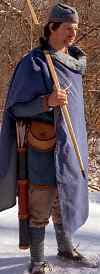 |
Subject: I chose for my hypothetical subject a 25 year old male, 72 inches tall (180cm), weighing 160 pounds (73 kg). This man has a basal energy expenditure of 1800 Kcal (7.6MJ), which means that he expends 1800 Kcal in a day on his basal metabolism, which includes no activities. Alternatively, it means that if he engaged in no physical activity, he would need to take in 1800 Kcal each day simply to maintain his body weight. |
|
Activities: I analyzed the caloric needs of the subject by creating a day full of hypothetical activities for him, including: 8 hours of sleep; 1 hour of horseback riding; 2 hours of chopping wood with an ax; 1 hour of heavy farm chores (e.g., forking hay bales); 4 hours of moderate farm chores (e.g., feeding animals); 4 hours of moderate walking; 1 hour climbing hills with a light load (5kg); 3 hours of "general activity". With this level of activity, the hypothetical subject expends 10700 Kcal (45MJ) in a day. |
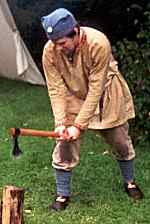 |
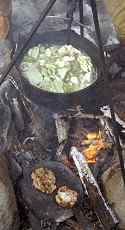 |
Menu: I created four different daily menus, one for each season of the year, using foodstuffs that are known to have been available to Norse era people. Lacking any better information, I used combinations of foodstuffs and proportions similar to what we prepare and consume at our Hurstwic feasts. For example, the flat bread we consume is made up of equal parts wheat, barley, oat, and rye flours, along with whey, honey, and nuts. The main dish is a boiled stew of meat (beef, pork, lamb, or fish) and vegetables (cabbage, leeks, onions, beans, and/or peas). Each of the four menus was designed to represent foods available during the different seasons of the year. For example, a wider variety and larger quantities of foods were used for the autumn diet, and fresh dairy products were deleted from the winter diet. As mentioned on the previous page, I was forced to revise upwards my estimates of quantities consumed in order to bring caloric intake more in line with probable caloric requirements of people in that era. One can easily imagine considerably more ale being consumed than I included in this diet. However, I suspect the ale consumed during a normal day was weaker than modern ales (which is what is in the database of the analysis software), so I intentionally reduced the quantity consumed to compensate. |
 |
The summer menu included:
|
425g |
15 oz. |
bread |
|
225g |
1½ cup |
fruit |
|
350g |
1½ cup |
fresh dairy products |
|
150g |
1¼ cup |
processed dairy products |
|
150g |
5 oz. |
fish |
|
300g |
11 oz. |
meat |
|
225g |
2 cups |
vegetables |
|
1500g |
1½ liter |
ale |
|
Diet Analysis: The table below summarizes the amount of various nutrients in the diet, averaged over the four days. The diet analysis software uses a database of nutritive values in food derived primarily from the United States Department of Agriculture Handbook Number 8, Composition of Foods. In addition, data from a wide variety of research studies has been incorporated into the database. The RDA column represents the percentage of the recommended dietary allowance established by the National Academy of Sciences in 1989. For some nutrients, the percentage indicates "estimated safe and adequate" amounts, and for others, "estimated minimum requirement". An asterisk indicates that at least one food analyzed has non-zero amounts of that nutrient, but there is insufficient information to reliably determine the actual amount. For instance, few foods in the data base have good information for vitamin E, since the vitamin is susceptible to destruction by a wide variety of agents. |
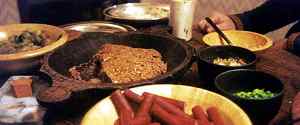 |
|
Nutrient |
Amount |
%RDA |
|---|---|---|
|
Energy |
3200 Kcal |
110 |
|
Protein |
211g |
335 |
|
Fat |
117g |
|
|
Carbohydrate |
273g |
|
|
Alcohol |
36g * |
|
|
Crude fiber |
11.7g * |
|
|
Dietary fiber |
0.0g * |
|
|
Saturated fatty acids |
54.1g |
|
|
Monounsaturated fat |
39.8g |
|
|
Polyunsaturated fat |
11.4g |
|
|
Cholesterol |
808mg * |
|
|
Vitamin A |
738 RE * |
74 |
|
Vitamin D |
0.9 µg * |
18 |
|
Vitamin E |
1.3mg a-te * |
13 |
|
Vitamin C |
68.6mg * |
114 |
|
Thiamine |
2.91mg * |
194 |
|
Riboflavin |
3.05mg * |
180 |
|
Niacin |
41.2mg * |
217 |
|
Pantothenic acid |
4.8mg * |
87 |
|
Vitamin B-6 |
3.3mg * |
163 |
|
Folacin |
249µg * |
125 |
|
Vitamin B-12 |
13.1µg * |
655 |
|
Calcium |
1470mg |
184 |
|
Phosphorous |
3400mg |
425 |
|
Magnesium |
457mg |
131 |
|
Iron |
20.3mg |
203 |
|
Zinc |
17.1mg * |
114 |
|
Copper |
2.0mg * |
89 |
|
Sodium |
1570mg |
313 |
|
Potassium |
4680mg |
234 |
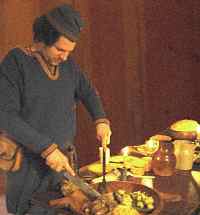 |
Comments: Only two nutrients show significant deficiencies, and in both cases, these deficiencies probably aren't real. Average vitamin D and E intakes are much lower than recommended. In both cases, the deficiencies in the database are to blame. The fatty fish consumed in this diet contain reasonable quantities of the fat soluble vitamins such as D and E, but the database shows no information for these nutrients for these foods. Nuts provide some vitamin E, although again, the database has no information. Liver, which is known to have been consumed, would also provide substantial vitamin D, although I didn't specifically include it in the menu. In addition, light skinned people, such as the Norse, would have no trouble synthesizing needed vitamin D from exposure to sunlight during all seasons except winter. In summary, it appears possible for Norse era families to have eaten balanced diets, in which they received their needed nutrients, assuming they were able to eat a variety of foodstuffs known to have been consumed during the Norse era. |
A few more details: As this was written, the RDA was being replaced with new recommendations called Dietary Reference Intakes (DRI). That work was not complete at the time I performed this study, so I used the older RDA information. Additionally, these recommended values have been developed by the Institute of Medicine of the National Academies in Washington, D.C., USA. Similar agencies in other countries have developed their own recommended values which may differ substantially from these values.
|
|
©2001-2026 William R. Short |